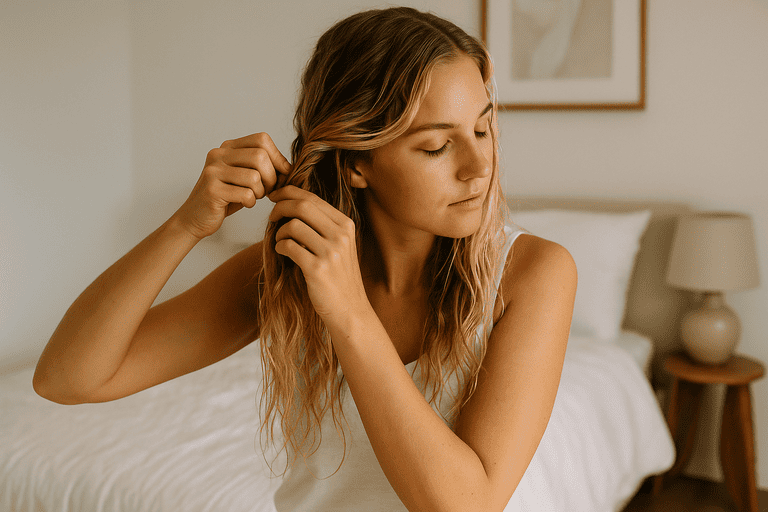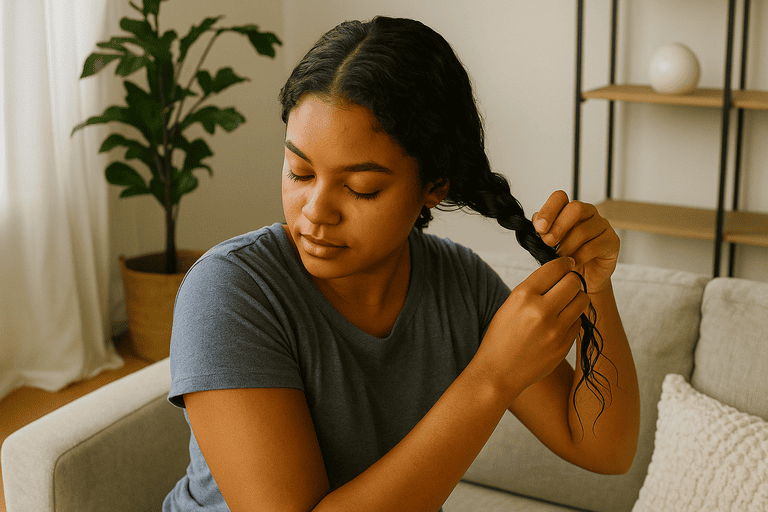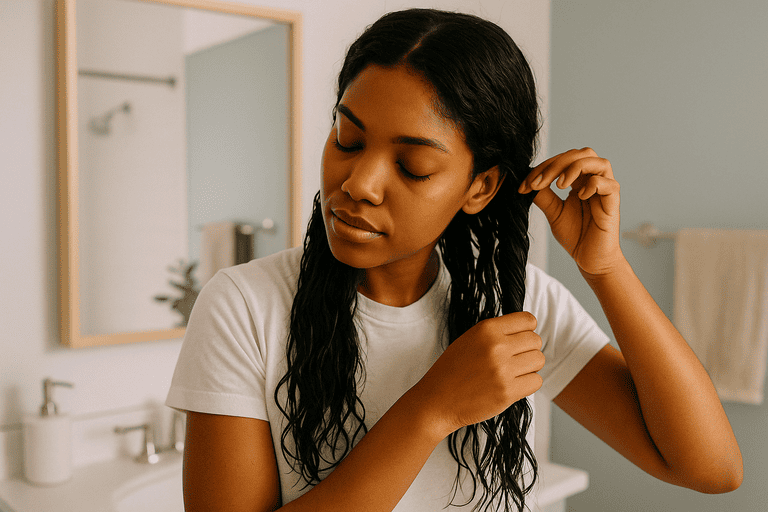If you’ve ever envied effortless, sun-kissed waves but don’t want to apply heat, learning how to make beach waves without a curling iron could transform your hair routine. The good news? You don’t need expensive tools or harsh heat to achieve this relaxed, summery style. With the right technique and a bit of prep, you can create soft, textured waves that look like you’ve just stepped off the sand.
This look works for nearly every hair length and type, making it one of the most versatile styles in the beauty world. Whether you’re heading to brunch, a casual date, or simply want to give your hair a break from hot tools, there are countless ways to style beach waves with zero heat. In addition, embracing your hair’s natural texture adds volume and movement—without damage.
Overnight Braiding: Your First Stop to Heat-Free Waves
One of the simplest ways to master how to make beach waves without a curling iron is to braid your hair before bed. Start with slightly damp hair and divide it into two or more sections, depending on your hair’s thickness. Loose braids result in softer waves, while tighter braids offer more defined texture. Secure with soft hair ties to prevent creasing.
In the morning, gently unravel the braids and run your fingers through your hair—no brushing required. For added texture, apply a lightweight sea salt spray or a touch of mousse. In addition, scrunching the ends upward boosts volume and gives a windswept finish.
This method is perfect for busy schedules because it works while you sleep. Therefore, it’s not only effective but also time-saving and kind to your strands.

Twisting and Clipping: Daytime Styling with Minimal Effort
Another method to achieve how to make beach waves without a curling iron involves twisting small sections of damp hair and pinning them in place. This technique works well during the day when you have time to let your hair air-dry naturally. Begin by dividing your hair into six to eight sections, twist each one away from your face, and secure them with bobby pins or small clips.
Allow the twists to dry completely. You can even go about your daily routine with them in, which makes this option incredibly convenient. Once dry, release the twists and tousle your hair gently. In addition, apply a touch of texturizing spray to help set the waves and reduce frizz.
How to Make a Perfect Ponytail: A Classic Style Reinvented
Because this style forms a more structured wave, it’s excellent for medium to long hair. Plus, you’re in control of the volume—more sections for tighter waves, fewer for a relaxed look.
Salt Spray and Scrunching: Beach Texture in a Bottle
If you want a truly low-maintenance route for how to make beach waves without a curling iron, sea salt spray is your best friend. Designed to mimic the texture your hair gets after a dip in the ocean, salt sprays add grit and hold without the crunchiness of traditional hairsprays. To use, spritz damp hair generously from roots to ends and scrunch with your hands.
Let your hair air-dry naturally or use a microfiber towel to remove excess water without creating frizz. In addition, flipping your head upside down while scrunching can add volume at the roots. If you have naturally wavy or slightly curly hair, this method enhances your natural pattern beautifully.
Sea salt sprays come in many formulations, so choose one with conditioning ingredients like coconut water or aloe vera to avoid drying out your strands.

Headband Waves: A Style Hack Worth Trying
This next method for how to make beach waves without a curling iron might surprise you—but it works. All you need is a stretchy headband and clean, slightly damp hair. Place the headband over your head like a crown, and begin tucking sections of your hair around it. Keep wrapping until all your hair is secured and let it set for a few hours—or overnight.
Once released, your hair will fall into soft, natural-looking waves. The headband technique is ideal for medium-length hair and great for people who don’t like sleeping in braids. In addition, this method is extremely gentle and leaves no harsh creases or dents.
Try this technique on days when you want to look styled but don’t want to commit to traditional updos. It’s both functional and chic.
Using Foam Rollers for Soft, Romantic Waves
For those who want a vintage touch, foam rollers provide a heat-free way to achieve elegant, beach-inspired waves. Choose medium to large rollers depending on the wave size you want. Roll damp hair from the ends up and secure. Sleep on them if they’re soft enough, or let your hair dry for several hours during the day.
In the morning, unroll carefully and run your fingers through the waves. In addition, setting your style with a flexible hold spray can help the waves last all day. Foam rollers offer a more uniform wave pattern and are especially effective for those with stubborn straight hair.
How to Put My Hair in a Bun Step by Step
This technique adds softness and volume, making it a favorite for date nights and special events.
Choosing the Right Products to Enhance Texture
When you’re learning how to make beach waves without a curling iron, product choice plays a crucial role. The right combination of leave-in conditioner, sea salt spray, and lightweight mousse can bring out your hair’s natural movement and hold the waves longer. Avoid heavy oils or thick creams that weigh your hair down or undo the wave pattern.
For fine hair, volumizing sprays give lift at the roots. Meanwhile, those with coarse or thick strands may benefit from curl enhancers that soften texture without making the hair greasy. In addition, a light mist of hairspray after styling helps lock in waves without making them stiff or crunchy.
Consistency matters. By using products that complement your hair type and chosen method, you ensure better results every time you wave.

Hairstyles to Try Once You’ve Mastered the Technique
Once you’ve figured out how to make beach waves without a curling iron, a world of versatile styles opens up. For instance, half-up buns with wavy ends look casual yet polished. Ponytails with textured waves add flair to a basic look. You can also twist the front sections into mini braids for a boho vibe that blends beautifully with wavy locks.
Beach waves also serve as a great foundation for fancier styles like loose chignons or side-swept updos. In addition, adding a scarf or decorative pin can elevate your look for brunch, parties, or even work settings. The goal is to embrace the imperfect, effortless charm of textured hair and build styles around it that suit your personality.
Once your waves are set, the creative possibilities are endless.
Nighttime Maintenance for Lasting Waves
After putting effort into your waves, you’ll want them to last. One way to preserve the style overnight is by loosely tying your hair into a high bun or pineapple. Use a silk or satin scrunchie to avoid dents and breakage. Sleeping on a satin pillowcase also helps maintain moisture and reduce friction.
If needed, lightly mist your hair with water in the morning and scrunch it to reactivate texture. In addition, reapplying a small amount of sea salt spray can refresh waves and add body. Avoid brushing your hair once styled—use your fingers to shape and detangle instead.
How to Do a French Braid Like a Pro
A good nighttime routine ensures that your waves last multiple days, making this heatless style even more practical and low-maintenance.
When to Wash and Reset
Eventually, buildup from products or natural oils will reduce the effectiveness of your wave techniques. Plan to wash and reset every 3–4 days, depending on your hair type. Use a clarifying shampoo to start fresh, followed by a moisturizing conditioner to restore balance.
Before repeating the process, assess which method worked best for you: braids, twists, headbands, or foam rollers. In addition, consider adjusting your product mix based on how your hair responded. Learning how to make beach waves without a curling iron becomes even more effective when you treat it as a cycle—style, maintain, refresh, and reset.
The more you practice, the better you’ll understand what your hair needs to create effortless, lasting texture.
Quick Recap
Let’s summarize everything we’ve covered in this complete guide to how to make beach waves without a curling iron, designed to give you salon-style texture from the comfort of your home.
We began with the basics: understanding how beach waves differ from curls and what makes the no-heat method so attractive. Then, we explored multiple ways to create waves—overnight braiding, daytime twisting, sea salt spraying, headband wrapping, and foam rolling—each suited to different hair types and lifestyles.
You learned how to enhance these methods with the right products and how to turn your waves into everyday or special occasion hairstyles. We also covered how to protect and preserve your look overnight, and when it’s time to refresh and reset your routine.
Ultimately, knowing how to make beach waves without a curling iron gives you freedom, flexibility, and a natural approach to beauty. With patience and practice, your hair can look effortlessly chic without any heat damage.

